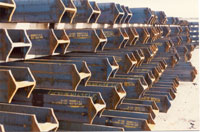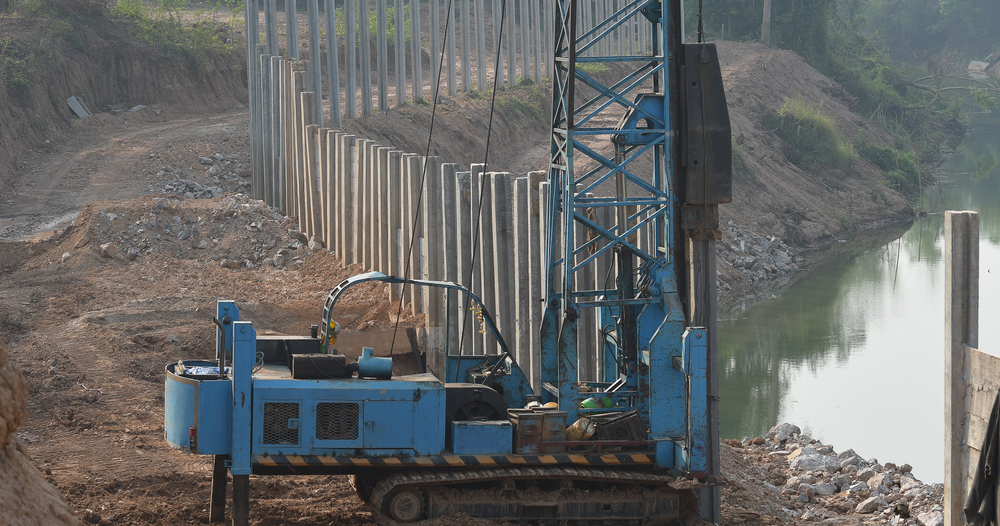H-Pile Points
 Driving steel H-piles in soils of moderate grain size is generally easy because of the non-displacement character of the pile. However, problems can arise when driving H-piles through man made fills, very dense gravel or deposits containing rock or even boulders. If left unprotected under these conditions, the pile tip may deform to an unacceptable extent and separation of the flanges and web may occur. Point attachments can help prevent these problems. Cast steel point reinforcement for H piles make it practical to drive through compacted fills, dense gravels and even penetrate below levels of possible scour in boulder river beds. Point attachments are also desirable for end bearing piles on rock particularly on sloping rock surfaces where a toe hold on rock is necessary. One piece points may be attached at the site with a minimum of labor and without turning the pile.
Driving steel H-piles in soils of moderate grain size is generally easy because of the non-displacement character of the pile. However, problems can arise when driving H-piles through man made fills, very dense gravel or deposits containing rock or even boulders. If left unprotected under these conditions, the pile tip may deform to an unacceptable extent and separation of the flanges and web may occur. Point attachments can help prevent these problems. Cast steel point reinforcement for H piles make it practical to drive through compacted fills, dense gravels and even penetrate below levels of possible scour in boulder river beds. Point attachments are also desirable for end bearing piles on rock particularly on sloping rock surfaces where a toe hold on rock is necessary. One piece points may be attached at the site with a minimum of labor and without turning the pile.
It is recommended that for a given set of subsurface conditions, pile points be considered equivalent, if they are manufactured from similar materials and by similar fabrication techniques. Minor variations in configuration should be given minimum importance, except in specific subsurface conditions where a certain shape would give a definite advantage.
 Several patented driving points are available as shown in figures 20-4(a) through 20-4(d). These points are attached to H-piles with fillet welds along the outside of each flange. Pile points fabricated from cast steel (ASTM A 27) are recommended because of their strength and durability.
Several patented driving points are available as shown in figures 20-4(a) through 20-4(d). These points are attached to H-piles with fillet welds along the outside of each flange. Pile points fabricated from cast steel (ASTM A 27) are recommended because of their strength and durability.
For most field welding E-60 or E-70 low hydrogen rod is favored. For semi-automatic welding AWS E 70T-G (Lincoln NR 211) flux-cored wire seems suitable for “out-of-position” and ordinary welding.
 NOTE: Some manufacturers fabricate points from ASTM A 36 rolled steel plates. The plates are cut and welded to form the required shape. Welds used to form these shapes are known to break under hard driving conditions and hence this type of fabricated point is not recommended. H-pile tips reinforced with plates welded to flanges and webs are not recommended because the reinforcement provides neither protection nor increased strength at the critical area of the flange to web connection. In addition, plate or plate and angle tip reinforcement requires handling four or six small pieces, turning the pile one to three times and making up to as much as 270 in. of weld. Much of this weld is in difficult and hard to reach areas between the flanges of the H.
NOTE: Some manufacturers fabricate points from ASTM A 36 rolled steel plates. The plates are cut and welded to form the required shape. Welds used to form these shapes are known to break under hard driving conditions and hence this type of fabricated point is not recommended. H-pile tips reinforced with plates welded to flanges and webs are not recommended because the reinforcement provides neither protection nor increased strength at the critical area of the flange to web connection. In addition, plate or plate and angle tip reinforcement requires handling four or six small pieces, turning the pile one to three times and making up to as much as 270 in. of weld. Much of this weld is in difficult and hard to reach areas between the flanges of the H.
This one-piece point is made to fit all weights of H in each nominal size. It attaches with a groove weld along the outside of each flange. The point is slipped on the pile and a vertical weld made along each flange. This must be full width of the flange. Welding only the ends overstresses the vulnerable corners). Preferred points will have a pre-bevel on the casting. This assures an even space for a proper weld. Should this pre-bevel not exist it may be necessary to field burn a 45 degree bevel along the outside of each flange of the H.
 When preparing for attachment of the point to the pile stack the H piles so the ends are accessible with the flanges vertical. (Stack the H-sections with the webs horizontal and the ends accessible to the welder. Alternate piles can be extended beyond the stack in each direction to achieve this.) The cast steel point can then be attached by holding it tight against the H and then making a simple grove weld along each side. By stacking the piles in this manner both sides may be welded, without having to turn the pile. If the cast steel point is not pre-beveled, an equal leg angle can be made to hand over the flange as a guide for a straight cut.
When preparing for attachment of the point to the pile stack the H piles so the ends are accessible with the flanges vertical. (Stack the H-sections with the webs horizontal and the ends accessible to the welder. Alternate piles can be extended beyond the stack in each direction to achieve this.) The cast steel point can then be attached by holding it tight against the H and then making a simple grove weld along each side. By stacking the piles in this manner both sides may be welded, without having to turn the pile. If the cast steel point is not pre-beveled, an equal leg angle can be made to hand over the flange as a guide for a straight cut.
NOTE: It is suggested that this weld should be a minimum of 5/16 in. and increased when attaching to material of more than 0.55 inch metal thickness.
A good weld is essential to hold the point reinforcement in position when it strikes tough obstructions or sloping rock at one edge only. Beveling across each flange of the H assures a base for a good weld and is essential for attachment of points.
For field welding of cast-steel points use of AWS E60 or E70 welding rod has been found satisfactory. Again, welding only along the full width of the outside of each flange is adequate, additional welding is not needed.
A definite plan should be made for the stacking of these piles with the pre-attached points. To minimize the need for additional handling, one should stack these piles out of the immediate work area, while still keeping them within reaching distance of the crane.NOTE: (Piles can be dragged either way so point reinforcement may be attached at alternate ends in the stack.)
It is customary to burn a small hole in the flange of the H, about one-fourth of the distance from the top, for a shackle connection for handling. This is by far the safest and quickest means of picking up the H.
-
 SPW911 Sheet Pile Design Software
Rated 5.00 out of 5$150.00 – $599.99Price range: $150.00 through $599.99
SPW911 Sheet Pile Design Software
Rated 5.00 out of 5$150.00 – $599.99Price range: $150.00 through $599.99 -
 Sheet Pile Design (PDF Download)
Rated 5.00 out of 5$89.00
Sheet Pile Design (PDF Download)
Rated 5.00 out of 5$89.00 -
 Pile Driving (PDF Download)
$89.00
Pile Driving (PDF Download)
$89.00
-
 Marine Construction Volumes 1 & 2 (PDF Download)
$157.00
Marine Construction Volumes 1 & 2 (PDF Download)
$157.00
-
 Pile Driving (Book)
$89.00
Pile Driving (Book)
$89.00










